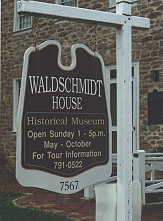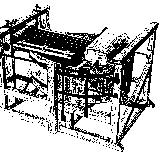In the early days of Cincinnati (and the whole Northwest Territory), the scarcity of paper was a serious problem. The closest paper mill was at Redstone, Pennsylvania, and the distance and the unpredictability of river traffic made delivery difficult and very erratic. The editor of the Cincinnati Western Spy wrote in 1804, “It is impossible to obtain paper at all seasons of the year, owing to the distance from whence we are mostly supplied.”
A paper mill was built in Georgetown, Kentucky, but it was small with very limited production and was several days’ journey away. A notice in the Chillicothe, Ohio Scioto Gazette, stated in 1802, “By reason of the river not having been navigable for some time past we have been disappointed in receiving a supply of paper. …Our readers will therefore excuse our issuing half a sheet.”
Newspapers were not alone in feeling the severe paper shortage. The Land Office was busy but often lacked necessary paper for deeds and indentures. Small size receipts and other documents were often written on scraps torn from letters or other used paper. Personal letters were short and infrequent because of the lack of paper. Benjamin Van Cleve wrote in his memoirs in 1794 that because of the paper shortage while surveying the Big Miami River he kept his field notes on tablets of wood with the point of his knife.
 Christian Waldschmidt’s arrival in the Cincinnati area was welcomed by those who needed paper. In 1810 Waldschmidt ran this advertisement in the Liberty Bell: “Rags Wanted. C. Waldschmidt, having commenced building a paper mill on the Little Miami, respectfully informs the public that store goods will be given for any quantity of clean linen and cotton rags, at three cents a pound. Rags will also be received as cash in payment of book accounts.”
Christian Waldschmidt’s arrival in the Cincinnati area was welcomed by those who needed paper. In 1810 Waldschmidt ran this advertisement in the Liberty Bell: “Rags Wanted. C. Waldschmidt, having commenced building a paper mill on the Little Miami, respectfully informs the public that store goods will be given for any quantity of clean linen and cotton rags, at three cents a pound. Rags will also be received as cash in payment of book accounts.”
Born in Pennsylvania in 1755, Christian Waldschmidt was the son of Johannes Waldschmidt, pastor of several churches in Berks and Lancaster counties. He Americanized his name to Waldsmith about 1786.
 Christian found work in a paper mill. Hearing reports of cheap land and golden opportunity in the Ohio country, Waldsmith took a group west. They landed at Columbia in Hamilton County and explored the Little Miami Valley in 1794. They found “Big Bottom” a few miles upstream from the mouth of the east fork, with fertile ground and ample springs, which they named Germany. Waldsmith purchased from John Cleves Symmes over one thousand acres for one dollar per acre. Damming the Little Miami River, they built a mill race along which they erected a saw mill, a grist mill, and a paper mill. They also built a church, a distillery, a warehouse, stockyards, and homes on this land, and the community became a thriving and productive enterprise. (The stone Waldsmith house, the Kugler house, and some outbuildings are still at that location in Camp Dennison today.)
Christian found work in a paper mill. Hearing reports of cheap land and golden opportunity in the Ohio country, Waldsmith took a group west. They landed at Columbia in Hamilton County and explored the Little Miami Valley in 1794. They found “Big Bottom” a few miles upstream from the mouth of the east fork, with fertile ground and ample springs, which they named Germany. Waldsmith purchased from John Cleves Symmes over one thousand acres for one dollar per acre. Damming the Little Miami River, they built a mill race along which they erected a saw mill, a grist mill, and a paper mill. They also built a church, a distillery, a warehouse, stockyards, and homes on this land, and the community became a thriving and productive enterprise. (The stone Waldsmith house, the Kugler house, and some outbuildings are still at that location in Camp Dennison today.)
Waldsmith sometimes preached in the church and taught the children in school, in addition to managing the farm, store, and mills. He also owned a large warehouse in Columbia and was one of the first directors of the Cincinnati’s Miami Exporting Company, the first bank west of Philadelphia.
 The Waldsmith paper mill was in production before 1810, and the Western Spy reported in 1811 that, “Our impression appears for the first time on paper manufactured at Mr. Waldsmith’s new paper mill in Sycamore Township. Much praise is due Mr. Waldsmith for his unremitted exertions to furnish the neighboring printers with an early and constant supply. Nothing appears to be wanting to render this establishment of the greatest utility, except the care of the industrious housewife in saving her rags. The ladies in the community are informed that we shall hereafter give three cents a pound for rags in cash or four cents in books and stationery.” Waldsmith’s paper bore a distinctive watermark, the word “MIAMI” on one half of the sheet and the letters “W & CO” on the other half.
The Waldsmith paper mill was in production before 1810, and the Western Spy reported in 1811 that, “Our impression appears for the first time on paper manufactured at Mr. Waldsmith’s new paper mill in Sycamore Township. Much praise is due Mr. Waldsmith for his unremitted exertions to furnish the neighboring printers with an early and constant supply. Nothing appears to be wanting to render this establishment of the greatest utility, except the care of the industrious housewife in saving her rags. The ladies in the community are informed that we shall hereafter give three cents a pound for rags in cash or four cents in books and stationery.” Waldsmith’s paper bore a distinctive watermark, the word “MIAMI” on one half of the sheet and the letters “W & CO” on the other half.
Waldsmith’s paper business grew and more help was needed. The following newspaper notice appeared: “Paper Mill. Wanted five or six boys and girls, about 14 years of age, as apprentices to the paper making business, at the subscriber’s paper mill on the Little Miami, to whom good encouragement will be given. He will give cash, paper or store goods for any quantity of rags, delivered at his mill. C. Waldsmith”
A few months later Waldsmith ran an advertisement: “C. Waldsmith will engage six or eight boys as apprentices to the paper-making business. From 15 to 16 years of age–of good moral character. He will give one hundred dollars in cash, and a suit of clothes worth twenty-five dollars when free, and nine months night schooling in the time. Rags will be received as formerly.” The business continued to grow, and by the end of 1811 Waldsmith was adding equipment and sought to hire “experienced hands” and also someone to take over his school teaching.
Christian Waldsmith died unexpectedly at the age of 59 during the influenza epidemic of 1814. He was a recognized and prosperous businessman who founded a local industry to satisfy a definite need. Thanks to vision, leadership, and shrewd business sense, Waldsmith established in four short years a highly successful papermaking operation that was of benefit to the whole community.
